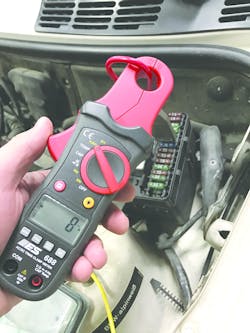Tool categories:
- Battery and charging system testers
- Battery monitor reset tools
- Battery chargers
- Oscilloscopes/lab scopes/waveform viewers
- Digital multimeters (DMMs)
- Scan tools
- Circuit testers
- Specialty testers
Since so much of today’s vehicles rely on electrically driven components it is important to understand the role of different tools and equipment in diagnosing electrical systems correctly and efficiently.
Even though many of the tool categories are able to perform electrical tests on circuits and components, some types of tools are better than others by either improving efficiency or the quality of data the tool provides.
Battery and charging system testers
First and foremost in any electrical test it is important to evaluate the battery and charging system. Most late-model vehicles utilize the PCM to control battery charge rates based not only on load demands, but on the quality of the battery as well. It is necessary to utilize a quality battery/charging system tester to load test the battery and to determine if the charging system has the ability to perform under all conditions.
Many battery/charging system testers have the ability to print a record of the results that may be stored with the vehicle records and provided to the customer.
Battery monitor reset tools
Many late-model vehicles now require resetting the Battery Monitor System (BMS) after servicing the charging system or replacing the battery. The battery monitor works with the PCM to evaluate the battery and to adjust the charge rate to extend battery life.
Depending on the vehicle, resetting the BMS can be performed by using a scan tool, or a stand-alone tool designed specifically to the task.
Battery chargers
Not to be confused with battery and charging system testers, considerations for battery chargers today should include the types of batteries the unit services and how fast can the unit charge the battery. Due to different types of batteries (flooded, gel cell and glass mat) having different requirements for charging, it is necessary to have a battery charger that is capable of charging each type without damaging the battery. Glass mat and gel cell battery chargers typically utilize a slower charge rate and may be temperature regulated, while flooded batteries are able to use traditional chargers because they are not apt to overheat while charging.
An additional concern when purchasing a battery charger or maintainer is to assure it has the ability to deliver “clean” power in order to be useful when programming computer modules. Voltage spikes or varying voltages while charging during programming may cause damage to computer modules.
Oscilloscopes/lab scopes/waveform viewers
As a general rule, this category of tools will provide the most complete set of data, in most cases, when testing the functionality as well as the amount of current going to and through a circuit. Many accessories are also available for additional tests such as pressure transducers, ignition adapters, etc.
The benefits of using a scope or waveform viewer include the ability to:
- Adjust both the time and measurement scale to view the circuit
- Observe more than one circuit at a time
- Record waveform for comparison or future use
- Observe history and catch glitches (intermittent issues)
- Purchase and/or use accessories, such as pressure transducers, ignition adapters, etc., that can perform additional tests
Some drawbacks to using a scope or waveform viewer include:
- Additional time needed to set up tool. After familiarity with the process, this takes less time.
- An initial investment that may be considered expensive.
Digital multimeters (DMMs)
These tools are very good for measuring specific values such as voltage, amperage, resistance and pulse width. Consider these tools as viewing a snapshot, while a lab scope is a video of an event.
Benefits of multimeters include
- Relatively inexpensive
- Fast test results
- Portable
- Various test leads and adapters available
- Able to test high-voltage hybrid vehicles (with appropriate test leads and meter classification)
Drawbacks of multimeters include:
- The readings given are digitized and are an average of the represented value, versus an exact value
- Difficult to capture intermittent issues
Scan tools
Scan tools can be used to observe data the vehicle’s computer modules are producing. This can be useful to quickly determine if normal voltages are present on many components at the same time without the need to connect a tester to each individual component. Graphing capabilities are available to obtain readings over a period of time and to compare multiple data graphs simultaneously.
Benefits to using a scan tool for electrical system testing include the ability to:
- Quickly obtain and compare multiple values in digital format
- Quickly obtain and compare multiple values in graphing format
- Observe data without intrusion into connectors or wires
- Observe data from multiple modules
Drawbacks to using a scan tool for electrical system testing:
- Data interpreted by the PCM and tool may be different from actual measured values
- Depending on the quantity of PIDs observed, data may not be “live”
- Due to slower update rates, scan graphing values are not as precise as a lab scope
Circuit testers
There are as many uses for circuit testers as there are different types of them. Circuit testers range from standard test lights to state-of-the-art units that can read digital values of volts, ohms or amps. Many testers have the ability to supply power or ground in order to test components.
Specialty electrical system test tools
There are many specialty test products that can be used to test specific components. These include relay testers that replace a relay in a circuit and include a switch to provide power to the controlled circuit. This tester can be used to determine if a relay is faulty, if the circuit is faulty, or to control a circuit for additional testing.
Other relay testers allow test terminal access while the relay is in the circuit. These testers provide the ability to check power, ground and control. When combined with a circuit tester that provides power or ground. There are some self-contained relay testers that provide the ability to check control and function without the need of a circuit tester.
There are numerous ways to test amperage in a circuit, but in many cases it is necessary to tap into the circuit with an amperage tester wired in series. The latest versions of amp testers allow the ability to obtain amp readings by accessing the fuse.
Having the ability to test the actual amperage a component is invaluable in determining if the circuit is functioning properly. For instance, knowing the amperage a fuel pump is using to operate at a specific pressure and comparing it to a known value is a great way to determine faults within the system. If the pressure is correct, but the amperage is higher than normal, that could indicate a faulty pump, high resistance in the circuit, or a restriction in the fuel system.
Overall, there are a number of different electrical system tools and equipment to assist with analyzing and diagnosing a vehicle’s electrical system issues. The tools necessary for your shop are dependent on your needs and capabilities.
[Editor's Note 8/1/18: While this content first appeared in the December 2016 Professional Tools & Equipment News Electrical Supplement.t continues to be a relevant resource.]
About the Author

Barry Hoyland
Barry Hoyland has been in the independent aftermarket for more than 45 years as a technician, technician instructor, shop owner, and shop management consultant. He owned and operated a successful Southern California automotive repair center that offers complete auto care and specialized in emission and diagnostic services for over 28 years. Hoyland also owned a company that modified vehicles to perform as emergency response units and mobile command centers, incorporating high-end electronic components into today’s vehicles. Hoyland has experience with all size and types of vehicles including traditional gas, hybrid electric, alternative fuel, and heavy duty diesel trucks.
Hoyland has provided consulting services for many automotive shops, fleets, and government agencies in order to improve their operational efficiencies.
In addition, he has worked with many NHRA drag racing teams as a crew chief on supercharged alcohol and nitro-methane fueled cars and currently serves as a crew chief on a Top Alcohol Funny Car, a Nostalgia Funny Car, and a Nostalgia Alcohol Dragster
Hoyland holds certifications in ASE: A1, A6, A8, and L1, MACS 609, maintains a California Advanced Emission license, and a CDL with endorsements for double and triple trailers, tankers, and HazMat.
When he is not helping to run a shop in the Pacific Northwest, Hoyland travels across the U.S. as an instructor of technical and shop management courses, many of which he has developed.
